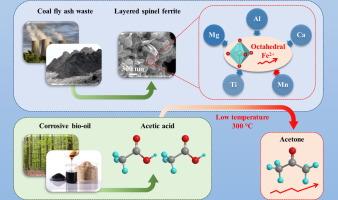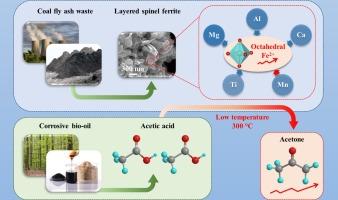从粉煤灰废料中简便合成作为稳定活性酮化催化剂的层状尖晶石铁氧体
IF 13.3
1区 工程技术
Q1 ENGINEERING, CHEMICAL
引用次数: 0
摘要
尖晶石催化剂在多种催化反应中表现出卓越的活性和结构稳定性。然而,很少有研究深入研究含有四种以上金属阳离子的尖晶石的合成,而传统的纯化学前驱体合成法成本高昂且会产生大量废物。在这里,我们展示了一种利用粉煤灰废料合成层状尖晶石铁氧体催化剂的简便、快速和可扩展的方法,否则会对垃圾填埋场生态系统造成危害。从废料中提取的最佳催化剂主要由 MgAl0.2Fe1.8O4 组成,由于在四面体和/或八面体铁位点上取代了各种阳离子(Ca2+、Mn2+、Mn3+ 和 Ti4+),催化剂的结构发生了扭曲,在适度温度(300 °C)下进行乙酸酮化反应时表现出了高活性(1.26 mmol-g-1-min-1)和稳定性(100 h)。酸度测量得出相应的周转频率为 2.21 分钟-1。在不同的金属阳离子和八面体 Fe2+ 物种之间观察到了强烈的协同作用;XANES 和原位 DRIFTS 表明后者是粉煤灰衍生尖晶石铁氧体中酮化的主要活性位点,促进了乙酸作为双齿乙酸酯的吸附以及随后与丙酮的 C-C 偶联。本文章由计算机程序翻译,如有差异,请以英文原文为准。


Facile synthesis of layered spinel ferrite from fly ash waste as a stable and active ketonisation catalyst
Spinel catalysts exhibit superior activity and structural stability across a wide range of catalytic reactions. Nevertheless, few studies have delved into the synthesis of spinels containing more than four metal cations, for which conventional syntheses from pure chemical precursors are costly and generate significant waste. Here we demonstrate a facile, rapid and scalable synthesis of layered spinel ferrite catalysts from fly ash waste that is otherwise detrimental to landfill ecosystems. The optimum waste-derived catalyst primarily comprised MgAl0.2Fe1.8O4, with a distorted structure due to the substitution of various cations (Ca2+, Mn2+, Mn3+, and Ti4+) at tetrahedral and/or octahedral iron sites, and demonstrates high activity (1.26 mmol⋅g−1⋅min−1) and stability (>100 h) for acetic acid ketonisation at a modest temperature (300 °C). Acidity measurements yield a corresponding turnover frequency of 2.21 min−1. Strong synergies are observed between the different metallic cations and octahedral Fe2+ species; XANES and in-situ DRIFTS indicate the latter is the primary active sites for ketonisation in fly ash-derived spinel ferrites, promoting both acetic acid adsorption as bidentate acetate and subsequent C–C coupling to acetone.
求助全文
通过发布文献求助,成功后即可免费获取论文全文。
去求助
来源期刊

Chemical Engineering Journal
工程技术-工程:化工
CiteScore
21.70
自引率
9.30%
发文量
6781
审稿时长
2.4 months
期刊介绍:
The Chemical Engineering Journal is an international research journal that invites contributions of original and novel fundamental research. It aims to provide an international platform for presenting original fundamental research, interpretative reviews, and discussions on new developments in chemical engineering. The journal welcomes papers that describe novel theory and its practical application, as well as those that demonstrate the transfer of techniques from other disciplines. It also welcomes reports on carefully conducted experimental work that is soundly interpreted. The main focus of the journal is on original and rigorous research results that have broad significance. The Catalysis section within the Chemical Engineering Journal focuses specifically on Experimental and Theoretical studies in the fields of heterogeneous catalysis, molecular catalysis, and biocatalysis. These studies have industrial impact on various sectors such as chemicals, energy, materials, foods, healthcare, and environmental protection.
 求助内容:
求助内容: 应助结果提醒方式:
应助结果提醒方式:


